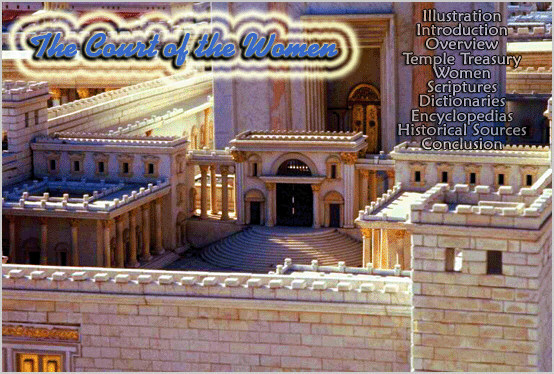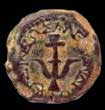The Court of the Women in the Temple
An Old Woman

Heart Message About Jesus and Giving

On Jesus� last and
final visit to Jerusalem He came and sat down in the Temple treasury which was
located in the spacious Court of the Women. He appeared very calm when He
deliberately sat down and gave notice to the passing crowd as they cast their
bronze coins into the trumpet shaped collection boxes of the treasury. He made a
very discriminating observation, many wealthy people cast in much, but there
came one poor peasant woman who was a widow, she had cast two mites, the
smallest of copper coins (less than two was not considered an offering), Jesus�
heart was deeply moved by her contribution. He called His disciples to Him and
said:
"Truly Truly, I say to you that this poor widow has put in more than all those
who have given to the treasury; for they all put in out of their abundance, but
she out of her poverty put in all that she had, her whole livelihood." (Mark 12)
Her gift was not
valued by how much was given in measure, but how much she had saved for herself.
But what is also
interesting is the person of Jesus. Lets pause for a moment and reflect what had
been happening for the past couple of hours and also what would be happening to
Him very soon, which He was well aware of.
Jesus had just
uttered a hailstorm of seven woes upon the Jewish leaders of Jerusalem, the
Scribes and the Pharisees. He blisteringly warned the people against their
vanity, their selfishness, their blindness and their hypocrisy. He called them
blind guides and "play actors" who hid behind a mask, haters of God and sons of
hell, who were slamming the door of the Kingdom of Heaven in the face of men.
He said all this
while standing by the altar, in the very place where the last Jewish prophet
Zachariah had been slain by the leaders of Jerusalem. There was a Jewish legend
that said that the blood of Zachariah had bubbled on the pavement of the Temple
court, the very place that Abel, the first martyr in the Bible, had been slain
by his brother Cain. Jesus had just accused the Jewish leaders and said that the
murder of Abel and of Zachariah and of every martyr of God in between would be
charged against them and their generation, because they were not only guilty of
slaying all the prophets but in a few hours they would slay the Son of God.
Jesus uttered their doom:
Luke 19:41-44 "If you had known, even you, especially in this your day, the
things that make for your peace! But now they are hidden from your eyes. For
days will come upon you when your enemies will build an embankment around you,
surround you and close you in on every side, and level you, and your children
within you, to the ground; and they will not leave in you one stone upon
another, because you did not know the time of your visitation."
Jesus, their
Messiah finished His terrifying indictment with a broken-hearted lamentation
over the beloved city:
Matt 23:37-39 "O Jerusalem, Jerusalem, the one who kills the prophets and stones
those who are sent to her! How often I wanted to gather your children together,
as a hen gathers her chicks under her wings, but you were not willing! See! Your
house is left to you desolate; for I say to you, you shall see Me no more till
you say, 'Blessed is He who comes in the name of the Lord!'"
The beloved city and
the awesome Temple would soon be places of desolation. How fearfully the
prophecy of this destruction was fulfilled. In 70 A.D. The Roman legions of the
Emperor Titus utterly destroyed the city and her glorious Temple in a few short
years. Over 1 million Jews perished in the siege in just a few days and over
100,000 were taken away into captivity.


It was just after
Jesus finished speaking this that He left the upper courts of the Temple for the
last time and exited through the Nicanor Gate and descended the 15 semi-circular
steps into the Court of the Women and took a seat in the treasury where He saw
the old widow casting her two copper coins into the charitable gift collection
box. With those who were seeking His death just a few paces away He was of a
calm spirit and peacefully took notice of this little old woman who would
forever etch the message into our hearts that the very essence of true charity
is self denial.

The Women's Court in the
Temple in Jerusalem

Mark 12:41-44 "Now Jesus sat opposite the treasury and saw how the people
put money into the treasury. And many who were rich put in much. Then one
poor widow came and threw in two mites, which make a quadrans. So He called
His disciples to Himself and said to them, "Assuredly, I say to you that
this poor widow has put in more than all those who have given to the
treasury; for they all put in out of their abundance, but she out of her
poverty put in all that she had, her whole livelihood."
The
Jerusalem Temple
 If you were to approach the Temple in
Jerusalem in the first century A.D. you would pass through the eastern gate
where Jesus made His triumphal entry. Then you would come to the Court of
the Gentiles which was a large court paved with stones of various colors. It
was open to all comers including the cattle-dealers and the money-changers
who desecrated the Temple. This court was also called the Outer Court, the
Lower Court, and the rabbi�s usually called it "the Mountain of the Lord�s
House." All around the Temple proper was a 9 foot high terrace with stairs
which was higher than the Court of the Gentiles. It was surrounded by a 5
foot high wall which was designed to keep out the gentiles. There was also
pillars in the wall at various distances (the Soreg) with inscriptions in
Latin, Greek, and Hebrew, warning all gentiles to come no further under
penalty of death.
If you were to approach the Temple in
Jerusalem in the first century A.D. you would pass through the eastern gate
where Jesus made His triumphal entry. Then you would come to the Court of
the Gentiles which was a large court paved with stones of various colors. It
was open to all comers including the cattle-dealers and the money-changers
who desecrated the Temple. This court was also called the Outer Court, the
Lower Court, and the rabbi�s usually called it "the Mountain of the Lord�s
House." All around the Temple proper was a 9 foot high terrace with stairs
which was higher than the Court of the Gentiles. It was surrounded by a 5
foot high wall which was designed to keep out the gentiles. There was also
pillars in the wall at various distances (the Soreg) with inscriptions in
Latin, Greek, and Hebrew, warning all gentiles to come no further under
penalty of death.
Going beyond the Court of the Gentiles and at the top of the terrace there
was a platform for about 15 feet and then there was another wall. On the
east side stood the magnificent 60 foot wide "Gate Beautiful" mentioned in
Acts 3:2,10. It was also referred to as the "Gate Susan" because it
contained a beautifully sculptured relief of the city of Susa. During the
time of the morning and evening sacrifices this great entrance was the place
of public worship.
Entering through the Susan Gate you would come to a large court called "the
Court of the Women" not because there were only women there but because
women could not go beyond it. There were smaller courts with columns in the
four corners of the court.
According to the Mishnah (Middoth 2,5) the Women's Court was was just over
200 feet square between bounding lines. Each court on the outside was 60
feet square.
In front of these columns were the eleven treasure chests of the Temple for
the voluntary offerings of money, and there were also two at the Gate of
Susan, for the half-shekel tax. Jesus was sitting �opposite the treasury'
when he saw the widow put into one of the containers the two copper coins
which were all that she had (Mark 12:41-44; Lk 21:1-2).
It was near these treasure chests that the man healed of his blindness came
up to Jesus in John 8:20 and worshipped Him.
Continuing eastward there was a magnificent circular staircase and the
Nicanor Gate. Entering through the gate there was a narrow hall filled with
beautiful cloistered columns called "Court of the Israelites" and it was
also through a wall and up a flight of stairs. The Court of the Israelites
surrounded the "Court of the Priests" which was where the altar of sacrifice
was. The women could only glance over a balcony from the Court of the Women
to see the ceremonies inside the Inner Court (According to Middoth).
Illustration
Introduction
Overview
Chel
Beautiful Gate
Nicanor Gate
Circular Steps
Levite Choirs
Oil of Yah Court
Nazarite Court
Leper's Chamber Court
Woodshed Court
Colonnades
Balconies
The Temple Treasury
Women
Scriptures
Dictionaries
Encyclopedias
Historical Sources
Heart Message
An Old
Woman - A Heart Message

Related Content